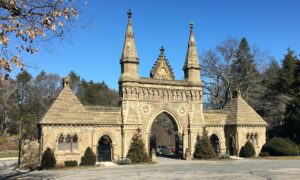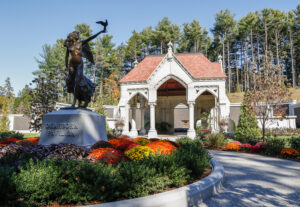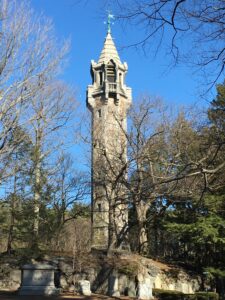By Peg Lopata, Contributing Writer

BOSTON – It certainly can’t be denied that the mountains might be the place to go on a fall day trip. But a beautiful and perhaps closer destination for many is the Forest Hills Cemetery in Boston’s Jamaica Plain neighborhood. This oasis, a garden cemetery, was established in 1848. It not only has fascinating gravestones, both new and old, it also has a modern sculpture area within its 250-acre park-like setting.
Where to begin
Perhaps the place to begin is with the historical gravesites. There are many notable ones, such as the grave of Dr. General Joseph Warren (1741-1775), physician, revolutionary leader and military officer during the American Revolution, and William Lloyd Garrison (1805 – 1879), journalist, publisher and prominent abolitionist.
To honor Union soldiers of the Civil War is the Soldier’s Lot, which includes a statue called “Citizen Soldier.” In its time this graceful statue was a remarkable figure. “This statue was one of the few sculptures which commemorated the rank-and-file soldier,” said Janice Stetz, the cemetery’s treasurer.
One can feel the soldier’s mourning as he gazes upon the graves of his fallen comrades. No wonder the statue was widely imitated.
“It became a popular prototype for Civil War statues throughout the country,” added Stetz.
A striking gravesite, funded by public donations, is the Fireman’s Lot, burying ground for Boston firefighters still used today. The site includes graves for thirteen firefighters who died in the line of duty and atop its mound towers a nine-foot-high statue, dedicated in 1909, of a firefighter. Mounted on its granite base are four beautifully rendered bronze relief tablets depicting scenes from a fireman’s life.
From a later era one can find the graves of numerous famous people, such as the poet e.e.cummings, playwright Eugene O’Neill, business leader Eben Jordan, co-founder of Jordan, Marsh & Co. department stores, and Boston Celtics former captain Reggie Lewis.
Sculpture tour

Photo/Billie-Jo Gauley
Cemeteries have always included funerary sculptures: angels, religious figures, decorative religious symbols and so on. Early on, the Forest Hills Cemetery became widely acclaimed for its Victorian-era sculptures. That tradition continues. In 2001, the Contemporary Sculpture Path, composed of a small permanent collection and works on loan was established.
“We are simply continuing the legacy of placing impressive sculpture in a peaceful, thoughtful setting,” said Stetz.
One sculpture of note, “The Sentinel,” of Harriet Tubman, was made by Fern Cunningham in 2003.
Another sculpture that makes one reflect on mortality is “The Boy in the Boat,” a white marble statue encased in glass memorializing a four-year-old who died in 1886 of diseases not uncommon in his time.
“Death Stays the Hand of the Sculptor” is by sculptor Daniel Chester French, best known for Washington, D.C.’s Lincoln Memorial and closer by, on the Harvard University campus, the statue of John Harvard, the first major benefactor of the university. The sculpture memorializes sculptors and brothers Martin and Joseph Milmore. Some of Martin’s monuments can be seen on the Boston Common.
Natural beauty

This cemetery is an open-air art museum of fascinating gravestones, monuments, sculptures and architecture. But it has also been called an arboretum cemetery. There are huge native and exotic trees. The variety includes mature oaks, cherry trees, sugar and Japanese maples, umbrella pines, weeping hemlocks and giant rhododendrons.
The terrain ranges from sloping low hills to rocky landscapes; from areas of natural woodland to formal Victorian flowerbeds. There’s even a lake. With the colors of fall, this cemetery will be worth any leaf-peeper’s stop. But it also offers something to explore for the historian and anyone who appreciates art and architecture.
Learn about the cemetery and upcoming events: https://www.foresthillscemetery.com/.
Want the armchair tour? Take a self-guided tour of some highlights of the cemetery: https://www.foresthillscemetery.com/self-guided-scholars-tour/.
RELATED CONTENT:
The road ended where it began for ‘The father of the Beats’ (fiftyplusadvocate.com)
Berkshire Botanical Garden showcases regional plants (fiftyplusadvocate.com)
Black Heritage Trail highlights how Boston became an abolition hotbed (fiftyplusadvocate.com)












